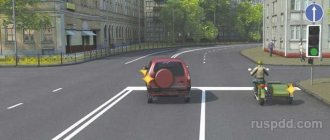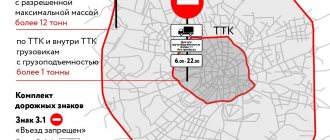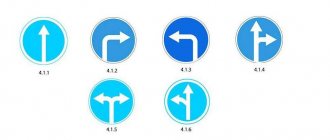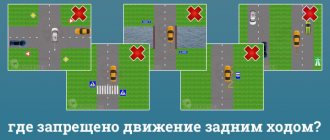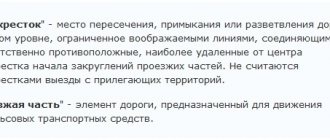What trajectory can you continue moving along?
| 1. | For any reason. |
| 2. | Only according to A. |
| 3. | Only by A or B. |
At this intersection there is a sign “Exit to a one-way road”, which does not prohibit movement straight and to the right. When turning, you should move as close as possible to the right edge of the roadway. Consequently, movement at the intersection can only continue along trajectories A and B.
Penalties
When moving towards the intersection, do not forget that there must be a sign in front of it (for example, 5.7.1 or 5.7.2), informing you about the road conditions in this area. If the driver violates the requirement of the sign, then penalties will follow.
On a note! Violation of the above signs may result in the loss of your license for up to 6 months. If there are no signs, there are no violations or penalties. What complaints can there be? Everything is fair.
What signs allow you to make a U-turn?
| 1. | Only A. |
| 2. | B and V. |
| 3. | All. |
Sign 3.18.2 “Left turn prohibited” (A) prohibits only a turn, but not a U-turn. Sign 5.7.2 “Exit onto a one-way road” (B) and sign 5.13.2 “Exit onto a road with a lane for route vehicles” (B) also do not prohibit turning around at the intersections of such roads.
What is a dividing strip and why is it needed?
A median strip is a designated element (usually raised) of the roadway that cannot be used for any movement (either by vehicles or pedestrians). Sometimes this part of the road is planted with green spaces, or tram traffic is organized along it.
The presence of such a lane requires the presence of two carriageways. Its absence indicates that the road is one whole. Yes, there may be markings on it, but nevertheless it continues to be a single roadway. Is it possible to make a U-turn at a one-way intersection with a median? And why not - what or who can stop you?! The main thing is that this dividing line is broken before the intersection begins. Carry out the maneuver in accordance with the traffic rules (not forgetting the signs of special regulations: 5.71 and 5.7.2) and enjoy life.
What signs allow a U-turn?
| 1. | A and B. |
| 2. | Only A. |
| 3. | All. |
Answer
| Sign A “Move to the left” allows for a U-turn, because Mandatory signs permitting left turns also permit U-turns. |
| Sign B “No left turn” prohibits a left turn, but not a U-turn. |
| Sign B “Entering a one-way road” does not prohibit turning. |
The correct answer is Everything.
What signs allow you to make a left turn?
| 1. | A and B. |
| 2. | B and V. |
| 3. | Only B. |
Answer
| You are allowed to turn left by a dead end sign (B), informing you that this road does not have a through passage. |
| You are allowed to turn left by sign B “Exit onto a road with a lane for fixed-route vehicles,” indicating that on the left lane, towards the main flow of vehicles, there is oncoming traffic of buses and (or) trolleybuses. |
| Sign A “Exit onto a one-way road” allows traffic at the intersection only to the right or straight, although it also allows for a U-turn in the opposite direction, but not a left turn towards oncoming traffic. |
The correct answer is B and C.
In what directions are you allowed to move?
| 1. | Just straight ahead. |
| 2. | Only to the right. |
| 3. | Straight or right. |
In this situation, the traffic controller does not change the existing traffic organization at the intersection. The traffic controller's signal and the road sign "Entering a one-way road" allow you to drive through the intersection only straight or to the right.
In what cases is a U-turn prohibited?
The Russian Road Traffic Rules for 2021 establish a complete list of situations and places where turning around is strictly prohibited. Such situations include when:
- the car is located directly at the pedestrian crossing.
Moreover, such a crossing must be marked with appropriate road signs, as well as road markings (pedestrian zebra crossing).
- in tunnels and tunnel passages, underground overpasses. Tunnels are also indicated by the corresponding road signs (This is sign 1.31, according to the “Technical Appendix” to the traffic rules)
- if the car is on bridges of all types, road overpasses, overpasses, road junctions, etc. It is also prohibited to maneuver in the form of a U-turn under these structures. All these structures and the entrances to them must be equipped with appropriate road signs. Here it is necessary to clarify that, for example, there are types of road overpasses that have a fairly long embankment in the form of a road surface adjacent to it. This part of the road also belongs to the overpass. Therefore, the driver should keep this in mind and not make a U-turn in such places, which violates this paragraph of the traffic rules.
- at all types of railway crossings. This applies not only to those railway crossings that are marked with traffic rules signs, but also to unattended and unmarked railway crossings, which are often found in rural areas and suburban areas.
- in those places on roads where visibility is limited for some natural reason - sharp turns, terrain, ups and downs, engineering structures, the driver's observation horizon can be limited to a distance of up to 100 m. Such places must be appropriately marked with road signs provided Traffic rules
- public transport stops - bus, trolleybus and tram stops. They must not only have structural forms, but also be marked with appropriate road signs. Those. the presence of stops in the form of a building does not yet mean that it is a public transport stop, within the meaning of the traffic rules.
- U-turn is prohibited in cases where it is expressly prescribed by road signs or signs indicating the direction of travel. In particular, such signs include complete prohibition signs, one-way road signs, etc.
- turning is prohibited in those places on the roadway where there are markings directly indicating the impossibility of turning. This single solid stripe or double solid stripe. Markup 1.3. according to the standards established by traffic regulations.
In what directions are you allowed to move?
| 1. | Just straight ahead. |
| 2. | Just straight and to the right. |
| 3. | Only straight, left and in the opposite direction. |
| 4. | In any. |
In this situation, the traffic controller does not change the existing traffic organization at the intersection. If you are in the right lane, you can only drive straight through the intersection, as the sign “Entering a one-way road” prohibits turning right. To make a left turn or U-turn, you had to take the left lane.
Which trajectory do the Rules allow you to make a left turn?
| 1. | Only according to A. |
| 2. | Only according to B. |
| 3. | For any reason. |
The “Exit to a one-way road” sign informs that on the roadway being crossed, traffic is carried out not only in the right, but also in the left lane. Therefore, you can turn left along either of the two paths.
Crossing roadways in two places
The question is not easy. The correctness of a U-turn at a one-way intersection with two intersections depends on the presence (or absence) of mandatory signs and on how organized the passage is on each individual section of the road.
Main! When making a U-turn, be careful not to end up in oncoming traffic.
If there are tracks at the intersection and trams move along them, remember that the solid marking line separating them from the roadway is nothing more than a dividing strip.
What trajectory can you use to make a turn?
| 1. | Only according to A. |
| 2. | Only according to B. |
| 3. | For any reason. |
In this case, a U-turn is prohibited only directly at the pedestrian crossing (trajectory B), the boundaries of which, in the absence of markings, are determined by “Pedestrian crossing” signs. At the intersection (trajectory A), a U-turn can be made, since the “Exit onto a one-way road” sign does not prohibit a U-turn.
U-turn technique
The general rules for performing a U-turn, including performing this maneuver at one-way intersections, are regulated by clause 8.5 of the Russian Traffic Regulations. In particular, the driver must adhere to the following techniques to safely perform this maneuver.
- We occupy the extreme left position on the roadway if we intend to turn right, and the extreme right position if we intend to turn left. This is necessary in order to have sufficient space for maneuver. If the width of the roadway is sufficient not to interfere with other vehicles, then you can perform the maneuver directly from the center of the roadway.
- We make sure that with our maneuver we do not create obstacles for transport traveling in the same direction.
- We turn on the turn signal in advance, indicating our intention to turn right or left.
- We expect that we will not completely interfere with the movement of passing traffic on our part of the road and will allow vehicles traveling along the other road of the intersection to pass.
- As soon as there is no traffic interfering with us on the crossing road, we drive out to the intersection and quickly complete the turning maneuver.
- If, at the moment of entering the intersection, a car appeared on the intersecting road, i.e. obstacle, then having this object of movement on the right, we let it pass and then complete our maneuver.
When performing such a maneuver, you should not rush. It is best to wait until there is a sufficient window of time in traffic on the intersecting road at the intersection in order to safely complete the U-turn maneuver. In a normal traffic situation, the turning maneuver takes no more than 10 -15 seconds.
In the situation of making a U-turn at an intersection, special cases may occur.
These are situations such as:
- For heavy vehicles or trailers - long vehicles may require more space to make a turn. In this situation, the driver of such a large vehicle can make a U-turn from the very right edge of the road or even its shoulder. Such a maneuver can only be carried out if all road participants are given advance warning of the intention using turn signals.
- in cases where at the intersection where it is supposed to perform a U-turn maneuver, there are no signs indicating the priority of traffic participants, the right of turn, then the maneuver is performed with the obligatory passage of all moving cars located on the right side.
When making a maneuver at an intersection, including one-way traffic, you must always let pedestrians pass at the place of the pedestrian crossing indicated by the appropriate traffic signs.


